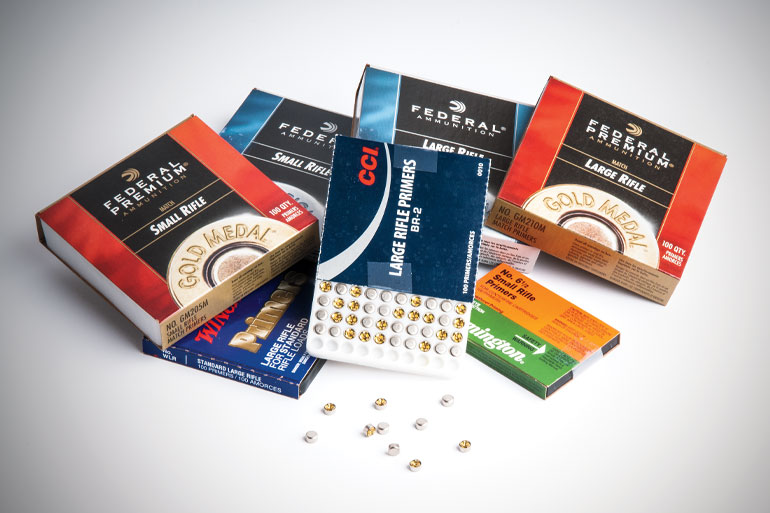The Greatest Guide To Winchester Primers
Table of ContentsReloading Primers Things To Know Before You BuyThe Only Guide for Primers In StockNot known Facts About Remington PrimersSome Known Details About Federal Primers The Greatest Guide To Remington Primers
Component of the firearm cartridge for launching propellant burning In guns and weapons, the primer () is the chemical and/or device liable for starting the propellant combustion that will certainly push the projectiles out of the gun barrel. In very early black powder weapons such as muzzleloaders, the primer was basically the same chemical as the primary propellant (albeit usually in a finer-powdered kind), however poured right into an exterior flash frying pan, where maybe sparked by an ignition resource such as a slow suit or a flintlock though some muzzleloaders have primers like cap weapon caps. winchester primers.
Instances include pistol cartridges, rifle cartridges, and also shotgun coverings. Bigger weapons items in contrast commonly utilize electric priming. In weapons the primers are regularly a different part, placed inside the barrel to the rear of the main propellant chargebut there are other instances of weapons, including for instance some automated weapons, created to fire cartridges with important electric guides.
The Facts About Reloading Primers Revealed

This opening was loaded with carefully ground powder, which was then sparked with a hot ember or torch. With the development of hand-held guns, this ended up being an undesirable method of firing a gun. Holding a burning stick while attempting to put a charge of black powder carefully down a barrel is dangerous, and trying to hold the gun with one hand while concurrently intending at the target and looking for the touchhole makes it extremely challenging to fire properly. [] The first effort to make the procedure of firing a tiny arm simpler was the "matchlock".
The match was a slow-burning fuse constructed from plant fibers that were taken in a remedy of nitrates, charcoal, and sulfur, and dried out (https://www.jobsrail.com/author/relodprim3rs/). This "slow-match" was sparked prior to the weapon was required, as well as it would gradually shed, maintaining a hot coal at the burning end. After the weapon was packed and the touchhole primed with powder, the burning tip of the match was placed to make sure that the lock would bring it right into contact with the touchhole.
What Does Pistol Primers Mean?
This brought the match down to the touchhole, sparking the powder. With cautious focus, the slow-burning match could be maintained burning for extended periods of time, as well as the use of the lock device made fairly precise fire possible. The following revolution in ignition innovation was the "wheel-lock". It used a spring-loaded, serrated wheel which scrubed against a piece of iron pyrite, comparable to a modern-day lighter.

The covered flashpan likewise offered some capacity to hold up against negative weather condition. The wheel-lock appreciated only a brief period of popularity prior to being superseded by a less complex, more durable style.
Federal Primers Can Be Fun For Anyone
The flint was held in a spring-loaded arm, called the "dick" from the resemblance of its activity to a pecking chicken. The dick rotated via around a 90-degree arc and was held in the tensioned, or "cocked" placement by a trigger.
The "half-cock" setting held the penis halfway back, as well as made use of a deep notch to make sure that shooting would not release the dick. Half-cock was a security setting, used when packing, saving or lugging a packed flintlock. The "full-cock" placement held the penis completely back and was the setting from which the gun was discharged.
It acted as both a flashpan cover and also a steel striking site here surface for the flint. The frizzen was pivoted as well as spring-loaded to make sure that it would secure the open or closed placement. When shut, the striking surface area was placed so that the flint would strike at the appropriate angle to create a trigger.
The smart Trick of Winchester Primers That Nobody is Talking About
The flintlock mechanism was simpler as well as more powerful than the wheel-lock, as well as the flint as well as steel gave a good, trustworthy resource of ignition. The flintlock stayed in armed forces service for over 200 years, and also flintlocks are still made today for historic re-enactments as well as muzzle-loading target competition, and for seekers that take pleasure in the extra challenge that the flintlock supplies.
By the center of the 19th century, the percussion or caplock system was well established., as it was easier and also more dependable than the flintlock.
The flashpan and also frizzen were removed and also changed by a little, hollow straight cyndrical tube (drum) screwed right into the bored-out as well as tapped flash hole as well as bring a "nipple" over which the cap might be fitted. A "hammer" which additionally had half-cock (for loading and using the cap) and full-cock settings replaced the dick.